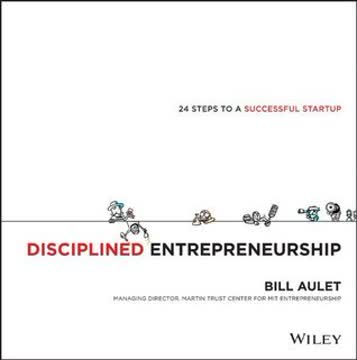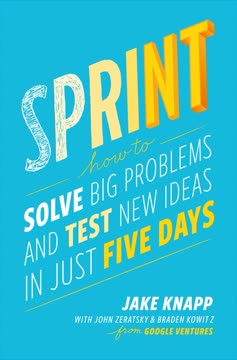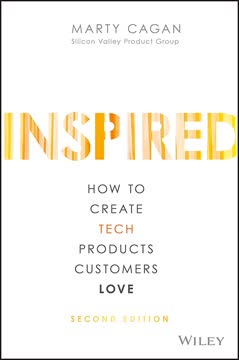Key Takeaways
1. Market Failure is the Norm, Not the Exception
Most new products will fail in the market, even if competently executed.
The Law of Market Failure. This hard truth underscores the high risk associated with launching new products. It's not a matter of if failure is an option, but acknowledging that it's the most likely outcome. This perspective shifts the focus from blindly pursuing ideas to rigorously validating them.
Defining Market Failure. Market failure occurs when the actual results of a new product launch fall short of or are the opposite of the expected results. This can manifest as lower-than-projected revenue, minimal market share, or outright cancellation of the product. Examples include:
- A restaurant opening a second location that fails to attract customers
- A company launching a new product that doesn't sell well despite positive reviews
Embrace the Reality. Accepting the Law of Market Failure is the first step toward mitigating its impact. By acknowledging the high probability of failure, businesses can adopt a more cautious and data-driven approach to product development.
2. Competent Execution Cannot Guarantee Success
Although experience and competence are necessary to achieve lasting success with a product that the market wants, they are powerless when applied to a product that the market is not interested in.
Beyond Skill and Effort. While a skilled team and diligent effort are essential, they are insufficient to overcome a flawed product premise. Many products fail not because of poor execution, but because they are simply not what the market desires. Examples include:
- Coca-Cola's New Coke, despite the company's marketing expertise
- Google Wave, despite Google's technological prowess
The Success Equation. Success depends on multiple key factors, all of which must be "right" for a product to succeed. A single "wrong" factor can lead to failure, regardless of how well other factors are executed. This highlights the importance of validating the core premise before investing heavily in development.
Blindness of the Law. The Law of Market Failure is impartial, affecting both experienced and inexperienced teams. Competence can even amplify the impact of failure by leading to larger investments and higher expectations.
3. Thoughtland is the Enemy of Market Validation
You cannot determine if an idea is The Right It just through thinking.
The Illusion of Understanding. Thoughtland is the realm of abstract ideas and opinions, where market research often relies on focus groups and surveys. These methods can be misleading because they fail to capture real-world behavior.
The Four Trolls of Thoughtland:
- Lost-in-Translation Problem: The way you imagine the product may differ from how others interpret it.
- Prediction Problem: People are notoriously bad at predicting their future behavior.
- Skin-in-the-Game Problem: Opinions are cheap when there's nothing at stake.
- Confirmation Bias Problem: We tend to seek evidence that confirms our existing beliefs.
False Positives and Negatives. Thoughtland can produce both false positives (convincing you to pursue a doomed idea) and false negatives (discouraging you from a potentially successful one). Webvan, the online grocery delivery service, is a classic example of a false positive, while the initial skepticism surrounding Airbnb exemplifies a false negative.
4. Data Trumps Opinions in Product Development
Make sure you are building The Right It before you build It right.
Google's Operational Principle. The mantra "Data beats opinions" emphasizes the importance of objective evidence in decision-making. This requires fresh, relevant, trustworthy, and statistically significant data.
The Pitfalls of OPD. Other People's Data (OPD) is market data collected by others for different purposes. It's often tempting to rely on OPD, but it can be unreliable due to issues of freshness, relevance, and provenance.
The Power of YODA. Your Own DAta (YODA) is market data collected firsthand by your team to validate your specific idea. YODA is far more valuable than OPD because it's tailored to your unique context and provides direct insights into your target market.
5. Pretotyping Validates Ideas Before Building
Make sure you are building The Right It before you build It right.
Testing Before Investing. Pretotyping is a method of quickly and cheaply testing the market demand for a new product idea before investing significant resources in development. It's about validating the "It" before building "It right."
The IBM Speech-to-Text Example. IBM used a "Mechanical Turk" pretotype to simulate a speech-to-text computer, using a hidden typist to transcribe users' speech. This allowed them to gather valuable data on user behavior without building a complex prototype.
Key Pretotyping Techniques:
- Mechanical Turk: Simulating functionality with human labor.
- Pinocchio: Creating a non-functional model to test user interaction.
- Fake Door: Measuring interest by offering a product that doesn't yet exist.
- Facade: Delivering the product manually behind a seemingly automated front.
- YouTube: Using videos to gauge interest and gather feedback.
- One-Night Stand: Offering a limited-time service to test demand.
- Infiltrator: Introducing your product into an existing sales environment.
- Relabel: Repackaging an existing product to test interest in a new concept.
6. The Skin-in-the-Game Caliper Measures Commitment
If there’s no market, there’s no way.
Beyond Opinions. The Skin-in-the-Game Caliper is a tool for evaluating the level of commitment demonstrated by potential customers. It assigns points based on the type of action taken, with higher points indicating greater commitment.
Levels of Commitment:
- Opinions and encouragement: 0 points
- Validated email address: 1 point
- Validated phone number: 10 points
- Time commitment (e.g., attending a presentation): 1 point per minute
- Cash deposit: 1 point per dollar
- Placing an order: 1 point per dollar
Prioritizing High-Value Data. By focusing on data with significant skin in the game, businesses can gain a more accurate understanding of market demand and avoid being misled by cheap talk.
7. The TRI Meter Guides Objective Decision-Making
Make sure you are building The Right It before you build It right.
Visualizing Likelihood of Success. The TRI (The Right It) Meter is a visual tool for assessing the likelihood of success based on pretotyping results. It uses a five-step scale ranging from "Very Unlikely" to "Very Likely."
Mapping Experimental Results. Each pretotyping experiment is represented by an arrow on the TRI Meter, indicating the degree to which the data supports the hypothesis. The Law of Market Failure is represented by a black arrow pointing to "Very Unlikely," serving as a constant reminder of the high risk of failure.
Interpreting the Results. The TRI Meter provides a framework for making objective decisions based on data. Multiple experiments are needed to counteract the Law of Market Failure and provide a reliable assessment of the idea's potential.
8. Plastic Tactics Enable Adaptability and Success
Make sure you are building The Right It before you build It right.
Adaptability is Key. Plastic Tactics emphasize the importance of being flexible and adaptable in the face of new information. Plans rarely go smoothly, so it's crucial to be prepared to adjust your approach based on market feedback.
Key Tactics:
- Think Globally, Test Locally: Validate your idea in a small, easily accessible market before expanding.
- Testing Now Beats Testing Later: Get your idea out of Thoughtland and into the market as soon as possible.
- Think Cheap, Cheaper, Cheapest: Minimize the cost of your experiments without sacrificing data quality.
- Tweak It and Flip It Before You Quit It: Explore variations on your original idea before abandoning it altogether.
The Power of Tweaks. Small adjustments to your product or business model can make a big difference in market acceptance. Don't be afraid to experiment and iterate based on the data you collect.
Last updated:
FAQ
What's "The Right It" about?
- Author and Purpose: "The Right It" by Alberto Savoia is a practical guide aimed at helping innovators and entrepreneurs ensure their ideas succeed in the market.
- Core Concept: The book introduces the concept of "The Right It," which is an idea that, if competently executed, will succeed in the market.
- Structure: It is organized into three parts: Hard Facts, Sharp Tools, and Plastic Tactics, each providing insights and tools to validate ideas before investing heavily in them.
- Personal Experience: Savoia draws from his own experiences with both successful and failed startups to illustrate the importance of validating ideas early.
Why should I read "The Right It"?
- Avoiding Failure: The book provides strategies to avoid the common pitfall of investing in ideas that are destined to fail, even if executed well.
- Practical Tools: It offers practical tools and techniques, such as pretotyping, to test ideas quickly and cheaply.
- Data-Driven Decisions: Emphasizes the importance of making decisions based on data rather than opinions or assumptions.
- Real-World Examples: Includes real-world examples and case studies that illustrate the application of the book's concepts.
What are the key takeaways of "The Right It"?
- Law of Market Failure: Most new products will fail in the market, even if competently executed.
- The Right It vs. The Wrong It: Success depends on identifying and executing "The Right It," not just any idea.
- Pretotyping: A method to test ideas quickly and cheaply to gather data before full-scale development.
- Data Over Opinions: Decisions should be based on data with skin in the game, not on opinions or assumptions.
What is "pretotyping" as described in "The Right It"?
- Definition: Pretotyping is a method to test the market potential of an idea quickly and inexpensively before developing a full prototype.
- Purpose: It helps determine if an idea is worth pursuing by collecting real-world data, not just opinions.
- Techniques: Includes methods like the Mechanical Turk, Pinocchio, and Fake Door pretotypes to simulate the product experience.
- Outcome: Provides valuable data to decide whether to proceed with, tweak, or abandon an idea.
How does Alberto Savoia define "The Right It"?
- Definition: "The Right It" is an idea for a new product that, if competently executed, will succeed in the market.
- Market Success: It implies that the market has a genuine interest and demand for the product.
- Competent Execution: Even the right idea requires competent execution to succeed.
- Contrast with The Wrong It: Unlike "The Wrong It," which fails despite good execution, "The Right It" aligns with market needs.
What are the best quotes from "The Right It" and what do they mean?
- "Data beats opinions": Emphasizes the importance of relying on data rather than subjective opinions when making decisions about new ideas.
- "If there's a market, there's a way": Suggests that if there is genuine market demand, solutions to challenges will be found.
- "Make sure you are building The Right It before you build It right": Highlights the necessity of validating the idea's market potential before investing in its development.
- "The Law of Market Failure": Acknowledges the harsh reality that most new products fail, underscoring the need for thorough validation.
What is the "Law of Market Failure" in "The Right It"?
- Definition: The Law of Market Failure states that most new products will fail in the market, even if competently executed.
- Implication: It highlights the importance of validating market demand before investing heavily in product development.
- Universal Challenge: This law applies to all industries and emphasizes the need for careful market research and testing.
- Foundation for the Book: It serves as a foundational concept that drives the need for the tools and techniques discussed in the book.
How does "The Right It" suggest using data to validate ideas?
- YODA vs. OPD: Emphasizes collecting Your Own DAta (YODA) rather than relying on Other People's Data (OPD).
- Skin in the Game: Data should come with some form of commitment or investment from potential customers.
- Pretotyping: Use pretotyping techniques to gather data quickly and inexpensively.
- Objective Analysis: Analyze data using tools like the TRI Meter to make informed decisions.
What is the "Skin-in-the-Game Caliper" in "The Right It"?
- Purpose: A tool to measure the level of commitment or investment from potential customers as a form of validation.
- Types of Skin: Includes financial investment, time commitment, and other forms of engagement.
- Quantifying Engagement: Assigns points to different types of engagement to assess the strength of market interest.
- Decision-Making: Helps prioritize ideas based on the level of market commitment.
How does "The Right It" address the fear of failure?
- Failophobia: Recognizes the fear of failure as a common barrier to innovation and encourages facing it with data-driven validation.
- Learning from Failure: Emphasizes learning from failures to improve future attempts and find The Right It.
- Iterative Process: Encourages an iterative approach to testing and refining ideas to reduce the risk of failure.
- Supportive Tools: Provides tools and techniques to minimize the impact of failure and increase the chances of success.
What is the "TRI Meter" in "The Right It"?
- Purpose: A tool to visualize and interpret the likelihood of an idea being The Right It based on collected data.
- Scale: Uses a five-step scale from Very Unlikely to Very Likely to assess the potential for market success.
- Multiple Experiments: Encourages running multiple experiments to gather sufficient data for a reliable assessment.
- Balancing the Odds: Helps balance the initial odds of failure with positive data from pretotyping experiments.
How can "The Right It" help entrepreneurs and innovators?
- Practical Guidance: Provides practical tools and techniques to validate ideas before significant investment.
- Reducing Risk: Helps reduce the risk of failure by emphasizing data-driven decision-making.
- Iterative Testing: Encourages iterative testing and refinement of ideas to find The Right It.
- Real-World Examples: Offers real-world examples and case studies to illustrate the application of concepts.
Review Summary
The Right It receives high praise for its practical approach to validating business ideas quickly and cheaply. Readers appreciate Savoia's clear explanations, engaging writing style, and actionable techniques for testing market demand. The book's emphasis on gathering real customer data and avoiding overinvestment in unproven concepts resonates with entrepreneurs. While some find the terminology excessive, most consider it an essential read for anyone launching a product or business, offering valuable insights beyond traditional market research methods.
Similar Books










Download PDF
Download EPUB
.epub digital book format is ideal for reading ebooks on phones, tablets, and e-readers.




